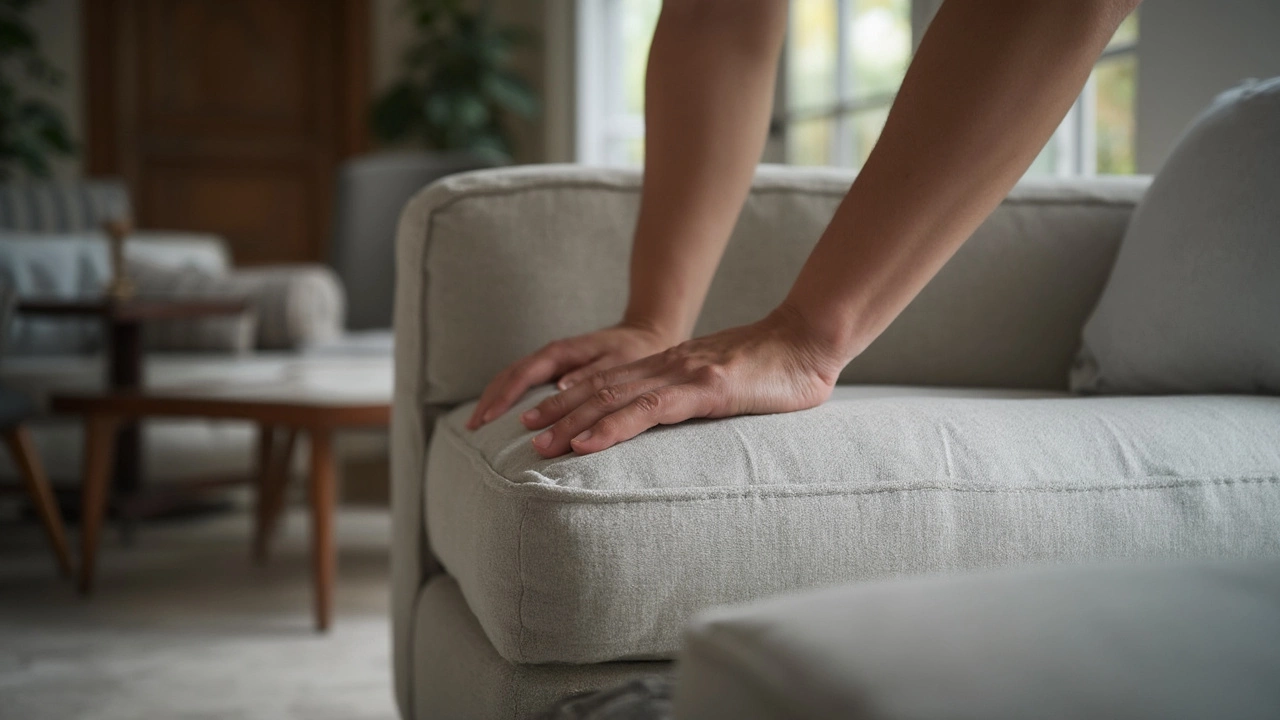How Can You Tell If a Sofa Is High-Quality? Simple Checks That Matter
 Apr, 25 2025
Apr, 25 2025
All sofas look comfy under store lights, but not all will survive years of everyday life. If you want to spot a real high-quality sofa, you’ve got to go past the pretty fabric and soft cushions.
Start by giving that sofa a little shake. If it wobbles or creaks, that's a red flag. Great sofas have sturdy, heavy frames—usually made from solid hardwood like beech or oak. If the label says “engineered wood” or “MDF,” walk away unless you're after something temporary. Real hardwood feels heavy if you try to lift a corner; it doesn’t feel hollow or bendy.
Flip up those seat cushions, peek underneath—yes, really. Check how the frame parts are joined. The gold standard? Look for wooden dowels, screws, or even brackets—never just glue, nails, or visible staples. If you see chunky, clean corners and solid joinery, you’re looking at a sofa that can handle some chaos, like jumping kids or movie marathons.
- Look Beneath the Surface: Frame and Joinery
- Cushions and Support: The Real Comfort Test
- Upholstery Tells the Truth
- Details That Separate the Good from the Great
Look Beneath the Surface: Frame and Joinery
When you really want to know if you’re dealing with a high-quality sofa, the secret is all in the frame. It’s never about the flashy colors or fancy patterns. The frame is the backbone—the thing that decides whether your couch is going to see you through game nights or end up in the alley in a couple of years.
Solid hardwood is the gold standard for frames. If you see materials like pine, particleboard, or anything labeled MDF, don’t expect it to last through years of regular use. On the other hand, beech, oak, or ash are signs you’re looking at something built to last. Not sure what you’re dealing with? Most sofa quality tags list the materials, but you can also tap a non-upholstered area—it should feel dense, not hollow.
The way pieces are connected matters just as much. Top-notch sofas rely on real joinery methods: dowels, corner blocks screwed into place, or even metal brackets. If you can peek under the sofa and see these, you’re on the right track. Visible staples, weak glue, or just nails? That’s cutting corners—literally.
Here’s a quick way to check the frame and joinery on any sofa you like:
- Lift one corner—if the whole sofa lifts, the frame is sturdy; if just that corner rises, it might twist or sag with time.
- Rock the armrest gently. Listen for squeaks or creaks—that’s the frame talking, and it shouldn’t talk.
- Feel around the base where the arm meets the seat. Does it feel solid or flimsy?
- Look for sturdy wooden “blocks” in the corners underneath. Cheap sofas skip these.
Fun fact: almost 70% of broken sofas from budget stores snap or come apart at weak joints long before the fabric wears out. That’s why pros say frame and joinery come first when checking sofa inspection boxes. Pay attention to these details and you’ll avoid the dreaded sag or snap.
Cushions and Support: The Real Comfort Test
No matter how good a sofa looks, if those cushions flop or squish flat after a month, you’ll regret it fast. High-quality sofas always pass the comfort test—and there’s actually some science behind it.
First thing to check: the core of the seat cushions. Good sofas usually use high-density foam (aim for something labeled at least 1.9 lbs per cubic foot) wrapped in a layer of feathers, fiber, or a softer foam. This combo keeps things from turning lumpy or saggy, even if you claim your spot every night. All-foam cushions can work, too, if the foam is dense, but cheap sofas cut corners with thin or spongy foam that just won’t last.
Next up—the structure underneath those cushions. Feel around for what’s supporting you. Top-tier sofas use either sinuous springs (like zig-zag shaped wires) or, even better, an eight-way hand-tied spring system. You can literally bounce on one of these and still get back support. Eight-way hand-tied sounds fancy, but it basically means craftspeople tied springs together in a grid with twine. It’s old school, and it works. Sinuous springs are also great—just make sure they’re spaced closely and feel firm, not saggy or rattly.
- High-quality sofa cushions should spring back quickly if you press down with your hand. If it feels flat or the imprint stays, that’s a red flag for bad foam or fiber.
- If you can unzip the cushion cover, do it. Durable cushions are often wrapped in muslin or have inner covers for extra longevity.
- Back cushions should have a bit more give than seat cushions, but they shouldn’t slouch down after a few months.
Here’s a quick breakdown comparing cushion fills you might find:
| Type | Typical Quality | What to Expect |
|---|---|---|
| High-density foam with feather wrap | Best | Supportive and soft, keeps shape for years |
| All polyfiber | Average | Soft at first, sags quickly |
| Low-density foam | Poor | Flattens fast, uncomfortable long term |
Before you buy, literally sit on every spot. A high-quality sofa won’t have dead zones or squeaky spots. The comfort should feel consistent across the whole seat—not just the center.

Upholstery Tells the Truth
Even if you find a sofa with a sturdy frame, poor upholstery can ruin your comfort fast. The fabric—how it's stitched and stretched—says everything about how long a high-quality sofa will last. Start with the cover fabric, whether it’s leather or textile. Fabrics like tightly-woven cotton, heavy-duty polyester blends, or top-grain leather age much better than vinyl or super-thin linen. If you feel the fabric and it seems thin, scratchy, or loose, that’s a shortcut for disappointment later on.
Check the seams. A sofa quality giveaway is straight sewing, no loose threads, and no gaps at corners. Cheap sofas often hide messy stitching where you can’t see it, especially under the cushions or at the back. Look at the pattern alignment, too. Got stripes or checks? If they don’t match up across the cushions, they rushed it at the factory. Crooked patterns mean the maker cut corners.
- Look at the zipper quality and how easy covers are to remove. Metal zippers usually outlast plastic ones and won’t break after a few washes.
- Run your hand over the cushions. If you feel lumps, uneven padding, or you can poke right through to the foam, that’s bad news. High-quality sofas use wrapped foam or a blend of foam and feather for a comfy, supportive feel.
- Check under the seat for lining—top-notch makers add protective lining under the cushions and the sofa base, while cheaper options leave the bottom bare.
If you want some quick comparison, check this table for fabric life spans—nothing fancy, just facts from real world use:
| Upholstery Material | Average Lifespan (Years) |
|---|---|
| Top-Grain Leather | 15+ |
| Heavy Synthetic Blend | 8-10 |
| Tightly-Woven Cotton | 5-8 |
| Vinyl/Faux Leather | 2-4 |
At the end of the day, run your hands, look with your eyes, check with common sense. The way the sofa inspection feels and looks tells most of the story. If the upholstery seems solid, chances are the rest of the sofa buying guide will pass the test too.
Details That Separate the Good from the Great
This is where a regular sofa gets left in the dust. A high-quality sofa always stands out thanks to the little things most people don't notice—but they make a massive difference in comfort and durability.
Let’s start with the feet. Are they just screwed in or “tacked” on, or are they built right into the frame? Built-in feet mean the frame won’t work loose or split over time. Now, peek at the seams and stitching. High-quality sofas use tight, straight stitching and double seams on stress points like corners and edges. Run your finger along them. Feel any gaps or loose threads? That’s a sign to keep moving.
The underside tells a story too. Turn the sofa over or ask a salesperson to do it. You want to see a dust cover that’s neatly attached, not just a cheap piece of fabric stapled crookedly. Even the bottom fabric should feel sturdy, not weak or see-through.
Check the cushions. The great ones keep their shape, even after hours of sitting. If they’re made of high-resilience foam wrapped in down, that’s the gold standard. Cheaper sofas use low-density foam that flattens fast. Some brands even list the foam density on their tags. Aim for at least 1.8 pounds per cubic foot if you want support that lasts.
Hardware also matters. Look at any zippers or fastenings. Metal hardware lasts way longer than plastic. Removable cushion covers with hidden zippers make cleaning much simpler—another little headache saved.
One last thing: labeling. Reliable manufacturers stand behind their sofas. If you spot a 10-year (or longer) warranty on the frame or the seat support, that’s not just marketing bluster. They’re betting you’ll never need it—because they’ve built their sofa to survive real life.
| Filling Type | Typical Density (lbs/cubic foot) | Durability |
|---|---|---|
| High Resilience Foam | 1.8 - 2.5 | 8-10 years |
| Polyurethane Foam | 1.2 - 1.5 | 2-3 years |
| Down & Feather Wrap | — | 10+ years (needs fluffing) |
Check for these small but important details and you’ll spot the real winners on the sofa quality spectrum every time.